

© Copyright 1995-2023, Clay Irving <clay@panix.com>
The won became the currency of North Korea on December 6, 1947, replacing the Korean yen that was still in circulation.
North Korean won are intended exclusively for North Korean citizens, and the Bank of Trade issued a separate currency — or foreign exchange certificates (FECs) — for visitors, like many other socialist states. However, North Korea made two varieties of foreign exchange certificates, one for visitors from "socialist countries" which were colored red, and the other for visitors from "capitalist countries" which were colored blue/green. In recent times, FECs have been largely depreciated in favor of visitors paying directly with hard currency, especially the euro.
North Korea Central Bank | ||||||||||||||||||||||
1947 Issue - First Won | ||||||||||||||||||||||
| After the division of Korea in 1945, North Korea continued using the Korean yen for 2 years until the Central Bank of the Democratic People's Republic of Korea was established on December 6, 1947 and a new currency was issued. Banknotes of this issue came in 15, 20 and 50 chon, and 1, 5, 10 and 100 won in 1947.
|
||||||||||||||||||||||
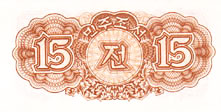 | P5 - 15 Chon Front: Denomination Back: Size: 86 x 44 mm | |||||||||||||||||||||
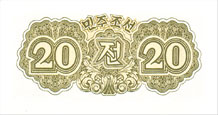 | P6 - 20 Chon Front: Denomination Back: Size: 85 x 44 mm | |||||||||||||||||||||
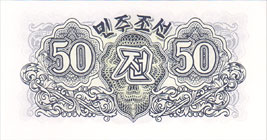 | P7 - 50 Chon Front: Denomination Back: Size: 104 x 54 mm | |||||||||||||||||||||
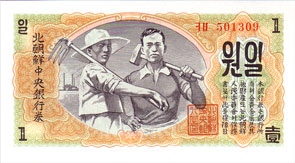 | P8 - 1 Won Front: Worker and farmer at center right Back: Mountain at center Size: 115 x 61 mm | |||||||||||||||||||||
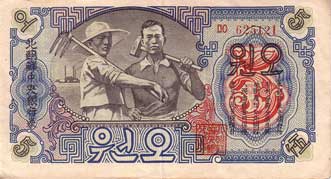 | P9 - 5 Won Front: Worker and farmer at left center Back: Mountain Size: 129 x 70 mm | |||||||||||||||||||||
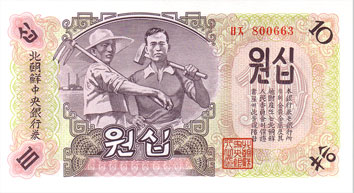 | P10A - 10 Won Front: Worker and farmer at center right Back: Mountain at center Size: 138 x 74 mm | |||||||||||||||||||||
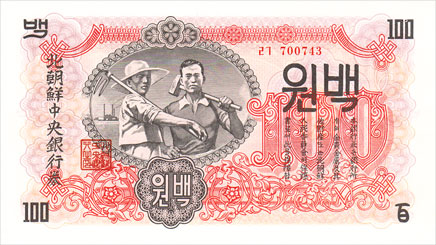 | P11 - 100 Won Front: Worker and farmer at center right Back: Mountain at center Size: 170 x 95 mm | |||||||||||||||||||||
Central Bank of the Democratic People's Republic of Korea | ||||||||||||||||||||||
1959 Issue - Second Won | ||||||||||||||||||||||
| 1947 First Won notes were replaced with the second in 1959 at a rate of one new won to 100 old won. | ||||||||||||||||||||||
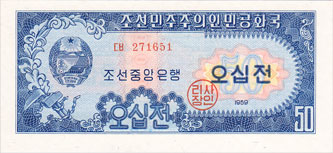 | P12 - 50 Chon Front: Denomination at right, arms at left Back: Denomination at center, ornamental designs Watermark: Jagged lines Size: 130 x 60 mm | |||||||||||||||||||||
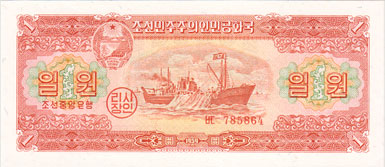 | P13 - 1 Won Front: Fishing boat at center, arms at upper left Back: Denomination at center, ornamental designs Watermark: Jagged lines Size: 150 x 65 mm | |||||||||||||||||||||
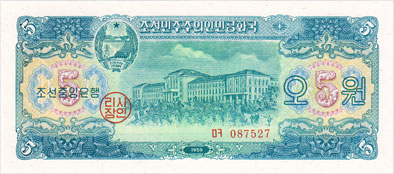 | P14 - 5 Won Front: Building at center, arms at upper left Back: Denomination at center, ornamental designs Watermark: Jagged lines Size: 154 x 68 mm | |||||||||||||||||||||
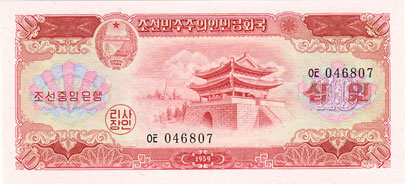 | P15 - 10 Won Front: Temple at center, arms at upper left Back: Woman picking fruit at center Watermark: Jagged lines Size: 158 x 72 mm | |||||||||||||||||||||
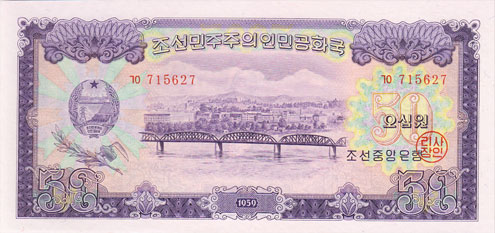 | P16 - 50 Won Front: Bridge at center, arms at left center Back: Woman with an armfull of wheat at center Watermark: Jagged lines Size: 193 x 90 mm | |||||||||||||||||||||
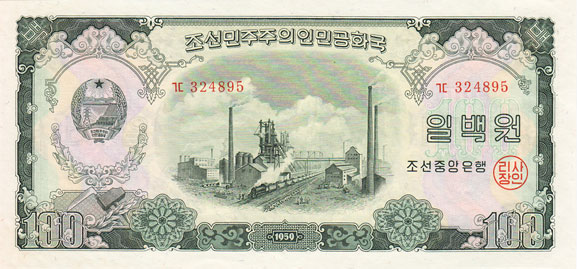 | P17 - 100 Won Front: Factory and steam train at center, arms at left center Back: River and mountains at center Watermark: Jagged lines Size: 225 x 95 mm This is a huge banknote! | |||||||||||||||||||||
1978 Issue | ||||||||||||||||||||||
| For the 1978 banknote series, foreign certificates (FECs) were implemented by overstamp and serial number color, except for the 100 Won Kim Il Sung value which was not given to foreigners:
| ||||||||||||||||||||||
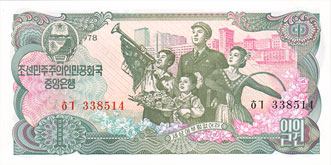 | P18a - 1 Won Issued for General Circulation Front: Two adults and two children at center, arms at upper left Back: Soldier at left, woman with flowers at center, woman at right Size: 129 x 65 mm | |||||||||||||||||||||
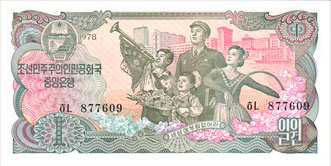 | P18b - 1 Won Issued for Socialist vistors Front: Two adults and two children at center, arms at upper left Back: Soldier at left, woman with flowers at center, woman at right, green seal with Korean text at lower left Size: 129 x 65 mm | |||||||||||||||||||||
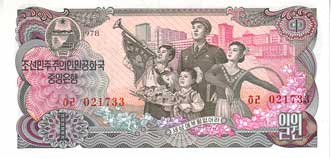 | P18c - 1 Won Issued for non-Socialist vistors Front: Two adults and two children at center, arms at upper left Back: Soldier at left, woman with flowers at center, woman at right, red seal with Korean text at lower left Size: 129 x 65 mm | |||||||||||||||||||||
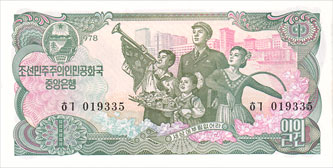 | P18e - 1 Won Issued for Socialist vistors Front: Two adults and two children at center, arms at upper left Back: Soldier at left, woman with flowers at center, woman at right, blue guilloché with value at lower left Size: 129 x 65 mm
| |||||||||||||||||||||
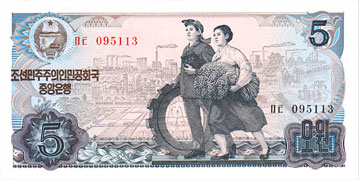 | P19a - 5 Won Issued for General Circulation (North Korean citizens) Front: Worker with book and gear and woman with wheat at center symbolizing industry and agriculture, city view with factories in background, arms at upper left Back: Taebaek Mountains with waterfalls with Mt. Gumgang at center Size: 140 x 70 mm | |||||||||||||||||||||
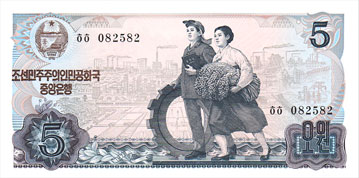 | P19b - 5 Won Issued for Socialist Visitors, 1983 Front: Worker with book and gear and woman with wheat at center symbolizing industry and agriculture, city view with factories in background, arms at upper left Back: Taebaek Mountains with waterfalls with Mt. Gumgang at center, green seal with Korean text at lower left Size: 140 x 70 mm | |||||||||||||||||||||
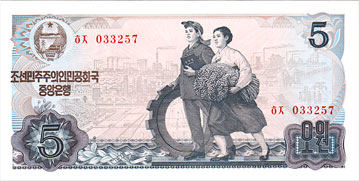 | P19c - 5 Won Issued for Non-Socialist vistors, 1983 Front: Worker with book and gear and woman with wheat at center symbolizing industry and agriculture, city view with factories in background, arms at upper left Back: Taebaek Mountains with waterfalls with Mt. Gumgang at center, red seal with Korean text at lower left Size: 140 x 70 mm | |||||||||||||||||||||
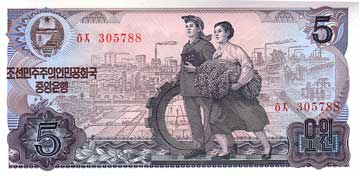 | P19d - 5 Won Issued for non-Socialist vistors, 1986 Front: Worker with book and gear and woman with wheat at center symbolizing industry and agriculture, city view with factories in background, arms at upper left Back: Taebaek Mountains with waterfalls with Mt. Gumgang at center, red guilloché with value at lower left Size: 140 x 70 mm | |||||||||||||||||||||
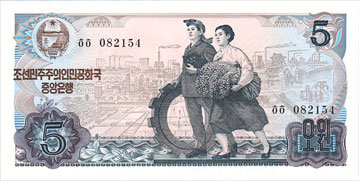 | P19e - 5 Won Issued for Socialist vistors, 1986 Front: Worker with book and gear and woman with wheat at center symbolizing industry and agriculture, city view with factories in background, arms at upper left Back: Taebaek Mountains with waterfalls with Mt. Gumgang at center, blue guilloché with value at lower left Size: 140 x 70 mm | |||||||||||||||||||||
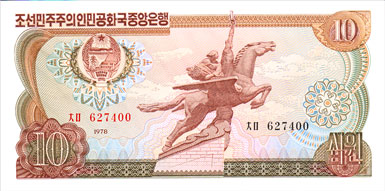 | P20a - 10 Won Issued for general circulation Front: Winged equistrian statue "Chollima" in Pyongyang at center, arms at upper left, red and black serial numbers Back: Waterfront factories, green seal at upper right Size: 150 x 74 mm | |||||||||||||||||||||
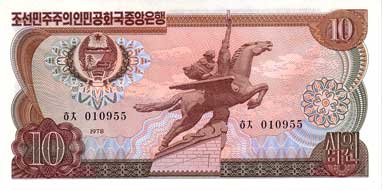 | P20b - 10 Won Issued for Socialist vistors Front: Winged equistrian statue "Chollima" in Pyongyang at center, arms at upper left Back: Waterfront factories, green seal at upper right Size: 149 x 74 mm
| |||||||||||||||||||||
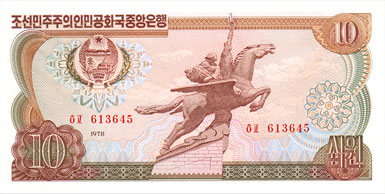 | P20c - 10 Won Issued for Capitalist vistors Front: Winged equistrian statue "Chollima" in Pyongyang at center, arms at upper left, red serial numbers Back: Waterfront factories, red seal at upper right Size: 150 x 75 mm | |||||||||||||||||||||
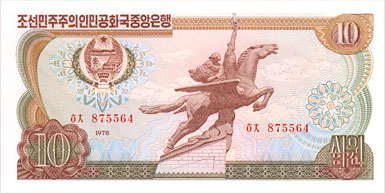 | P20d - 10 Won Issued for Capitalist vistors Front: Winged equistrian statue "Chollima" in Pyongyang at center, arms at upper left, red serial numbers Back: Waterfront factories, red guilloché with value at upper left Size: 150 x 75 mm | |||||||||||||||||||||
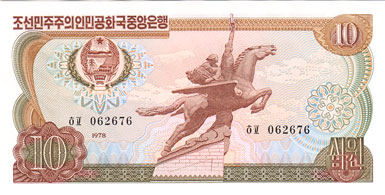 | P20e - 10 Won Issued for Socialist vistors Front: Winged equistrian statue "Chollima" in Pyongyang at center, arms at upper left, red serial numbers Back: Waterfront factories, blue guilloché with value at upper left Size: 150 x 75 mm | |||||||||||||||||||||
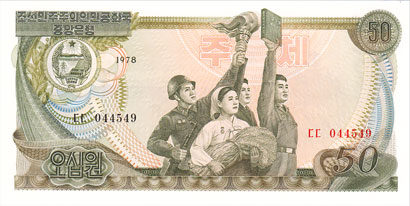 | P21a - 50 Won Issued for General Circulation Front: Soldier with man holding torch, woman holding wheat, man with book at center, arms at upper left, black serial number at left, red serial number at right Back: Lake scene at center Size: 160 x 80 mm | |||||||||||||||||||||
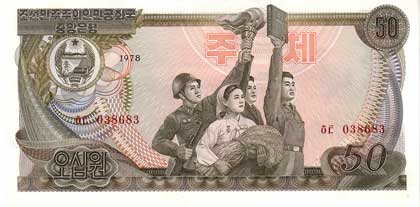 | P21c - 50 Won Issued for non-Socialist vistors Front: Soldier with man holding torch, woman holding wheat, man with book at center, arms at upper left Back: Lake scene at center, red seal at lower right Size: 160 x 80 mm | |||||||||||||||||||||
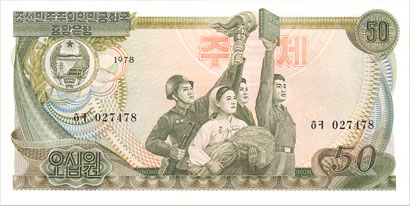 | P21e - 50 Won Issued for Socialist vistors Front: Soldier with man holding torch, woman holding wheat, man with book at center, arms at upper left Back: Lake scene at center, blue guilloché and value of note at lower right Size: 160 x 80 mm | |||||||||||||||||||||
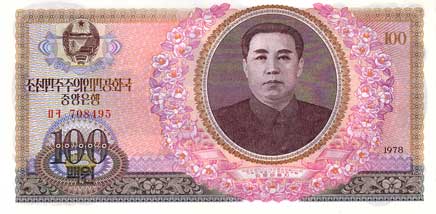 | P22 - 100 Won Note Front: Kim Il Sung at center right, arms at upper left Back: Birthplace of Kim Il Sung in Mangyongdae-guyok at center Size: 170 x 85 mm
| |||||||||||||||||||||
1988 "Capitalist Vistor" Issue | ||||||||||||||||||||||
| In 1988, the Bank of Trade (as opposed to the Central Bank) issued two unique series of foreign certificates. They both included 1 chon, 5 chon, 10 chon, 50 chon, 1 won, 5 won, 10 won, and 50 won. The series for "capitalist visitors" was blue-green, while the series for "socialist visitors" was pink. The chon notes had a simple design of patterns and the values, while the socialist won notes depict the International Friendship Exhibition, and the capitalist won notes depict the Chollima statue. | ||||||||||||||||||||||
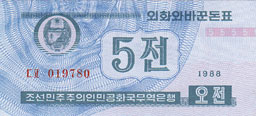 | P24 - 5 Chon Front: Denomination at center, arms at upper left Back: Denomination Size: 100 x 45 mm | |||||||||||||||||||||
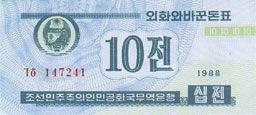 | P25 - 10 Chon Front: Denomination at center, arms at upper left Back: Denomination Size: 100 x 45 mm | |||||||||||||||||||||
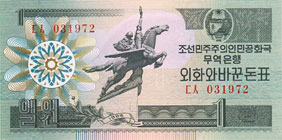 | P27 - 1 Won Front: Chollima at center, arms at upper left Back: Denomination Size: 110 x 55 mm | |||||||||||||||||||||
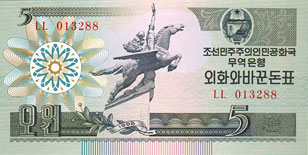 | P28 - 5 Won Front: Chollima at center, arms at upper right corner Back: Denomination Size: 120 x 60 mm | |||||||||||||||||||||
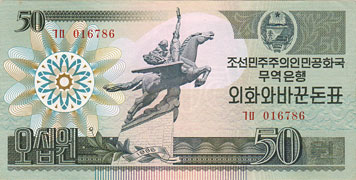 | P30 - 50 Won Front: Chollima at center, arms at upper right corner Back: Denomination Size: 120 x 60 mm | |||||||||||||||||||||
1988 "Socialist Vistor" Issue | ||||||||||||||||||||||
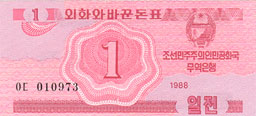 | P31 - 1 Chon Front: Denomination at center, arms at upper right Back: Denomination Size: 100 x 45 mm | |||||||||||||||||||||
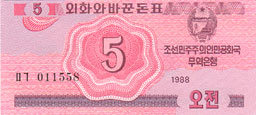 | P32 - 5 Chon Front: Denomination at center, arms at upper right Back: Denomination Size: 100 x 45 mm | |||||||||||||||||||||
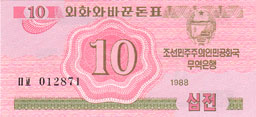 | P33 - 10 Chon Front: Denomination at center, arms at upper right Back: Denomination Size: 100 x 45 mm | |||||||||||||||||||||
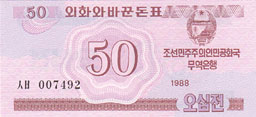 | P34 - 50 Chon Front: Denomination at center, arms at upper right Back: Denomination Size: 100 x 45 mm | |||||||||||||||||||||
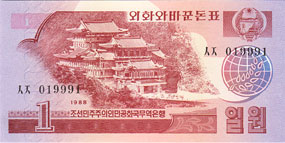 | P35 - 1 Won Front: Temple at center left, arms at upper right, olive branch on globe at right Back: Denomination at center, olive branch on globe at left Size: 111 x 55 mm | |||||||||||||||||||||
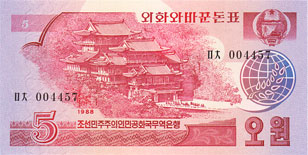 | P36 - 5 Won Front: Temple at center left, arms at upper right, olive branch on globe at right Back: Denomination at center, olive branch on globe at left Size: 120 x 60 mm | |||||||||||||||||||||
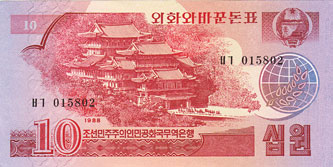 | P37 - 10 Won Front: Temple at center left, arms at upper right, olive branch on globe at right Back: Denomination at center, olive branch on globe at left Size: 130 x 65 mm | |||||||||||||||||||||
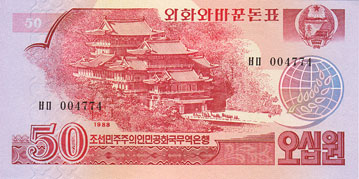 | P38 - 50 Won Front: Temple at center left, arms at upper right, olive branch on globe at right Back: Denomination at center, olive branch on globe at left Size: 140 x 70 mm | |||||||||||||||||||||
1992 Second Won Issue | ||||||||||||||||||||||
| 1992 Second Won Issue notes were issued from 1992 until December 2009 | ||||||||||||||||||||||
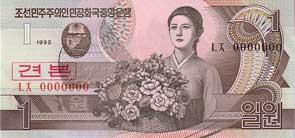 | P39s (CS2) - 1 Won, 1992 Specimen Note Front: Young woman with flower basket at center right, arms at upper left Back: Mt. Gumgang Watermark: winged equestrian statue ("Chollima") Size: 115 x 55 mm 견본 indicates "Specimen" in Korean. | |||||||||||||||||||||
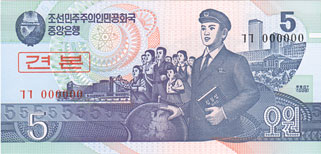 | P-40s (CS2) - 5 Won, 1992 Specimen Note Front: Kim Il Sung University in Pyongyang at upper right, Mangyongdae School Childrens' Palace in Pyongyangi at center left, students and pupils at center, symbol of an atom and nuclear power at upper left center, arms at upper left Back: Grand Peoples Study House on Mansan Hill in Pyongyang Watermark: winged equestrian statue ("Chollima") Size: 125 x 60 mm | |||||||||||||||||||||
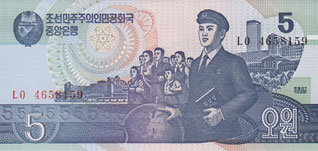 | P40 - 5 Won, 1992 Front: Kim Il Sung University in Pyongyang at upper right, Mangyongdae School Childrens' Palace in Pyongyangi at center left, students and pupils at center, symbol of an atom and nuclear power at upper left center, arms at upper left Back: Grand Peoples Study House on Mansan Hill in Pyongyang Watermark: winged equestrian statue ("Chollima") Size: 124 x 60 mm | |||||||||||||||||||||
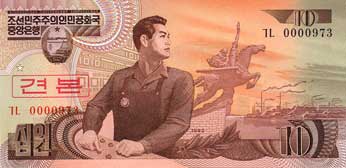 | P41s (CS2) - 10 Won, 1992 Specimen Note Front: Factory worker, winged equestrian statue ("Chollima") at center right, factories in the background at lower right, arms at upper left Back: Flood gates Watermark: winged equestrian statue ("Chollima") Size: 135 x 66 mm | |||||||||||||||||||||
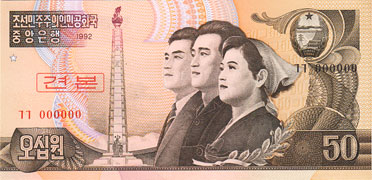 | P-42s (CS2) - 50 Won, 1992 Specimen Note` Front: Juche Tower at center left, young professionals at center right, arms at upper right Back: Landscape of pine trees and mountains Watermark: Top of Juche Tower Size: 145 x 70 mm
| |||||||||||||||||||||
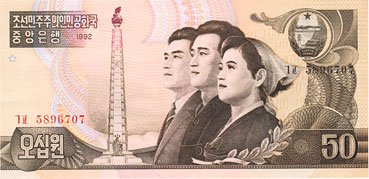 | P42 - 50 Won, 1992 Front: Juche Tower at center left, young professionals at center right, star at upper left mirror-images star on back at upper right, arms at upper right Back: Landscape of pine trees and mountains Watermark: Top of Juche Tower Size: 144 x 70 mm
| |||||||||||||||||||||
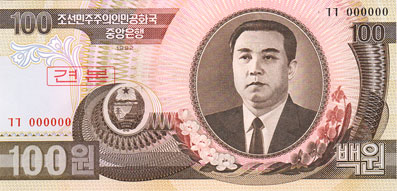 | P43s (CS2) - 100 Won, 1992 Specimen Note Front: Kim Il Sung at center right, flower design at upper left is mirror-image of flower design on back at upper right, arms at center left Back: Birthplace of Kim Il Sung in Mangyongdae-guyok at center Watermark: Arch of Triumph in Pyongyang Size: 155 x 75 mm | |||||||||||||||||||||
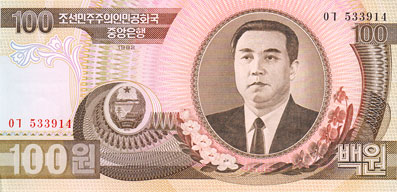 | P43 - 100 Won, 1992 Front: Kim Il Sung at center right, flower design at upper left is mirror-image of flower design on back at upper right, arms at center left Back: Birthplace of Kim Il Sung in Mangyongdae-guyok at center Watermark: Arch of Triumph in Pyongyang Size: 155 x 75 mm | |||||||||||||||||||||
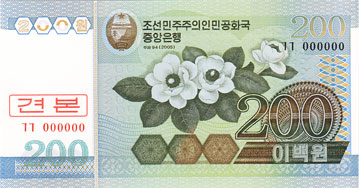 | P48s - 200 Won, 2005 Specimen Note Front: Magnolia flowers, the National Flower of North Korea, at center, arms at upper center left Back: Large value at center Watermark: winged equestrian statue ("Chollima") Size: 140 x 72 mm | |||||||||||||||||||||
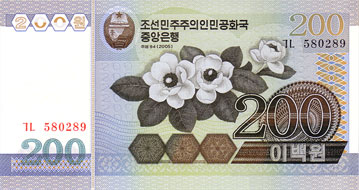 | P48 - 200 Won, 2005 Front: Magnolia flowers, the National Flower of North Korea, at center, arms at upper center left Back: Large value at center Watermark: winged equestrian statue ("Chollima") Size: 140 x 72 mm | |||||||||||||||||||||
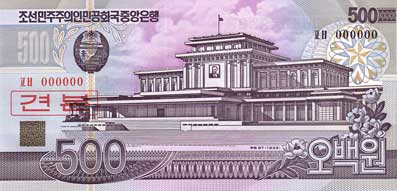 | P44s2 - 500 Won, 1998 Specimen Note Front: Kumsusan Memorial Palace, arms at upper left, roung ornamental design at upper right is mirror-image of the round ornamental design on the back at upper left Back: Suspension bridge Watermark: Arch of Triumph Size: 155 x 75 mm | |||||||||||||||||||||
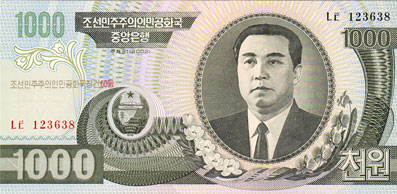 | P45 - 1000 Won, 2002 Front: Kim Il Sung at center right, arms at center left Back: Birthplace of Kim Il Sung in Mangyongdae-guyok at center Watermark: Arch of Triumph Size: 155 x 74 mm | |||||||||||||||||||||
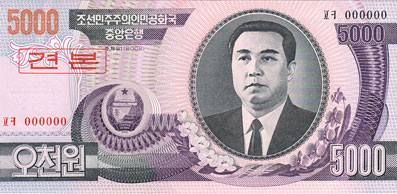 | P46 - 5000 Won, 2002 Specimen Note Front: Kim Il Sung at center right, arms at center left, dark background banner beneath denomination on bottom right and left front extends to note's edge Back: Birthplace of Kim Il Sung in Mangyongdae-guyok at center Watermark: Arch of Triumph Size: 155 x 74 mm | |||||||||||||||||||||
2006 Second Won Issue | ||||||||||||||||||||||
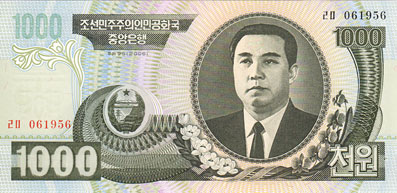 | 1000 Won, 2006 Front: Kim Il Sung at center right, arms at center left, dark background banner beneath denomination on bottom right and left front does not extend to note's edge Back: Birthplace of Kim Il Sung in Mangyongdae-guyok at center Watermark: Arch of Triumph Size: 155 x 74 mm | |||||||||||||||||||||
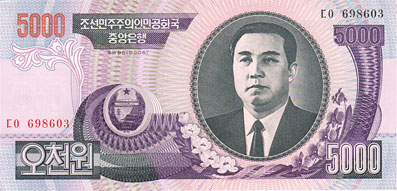 | 5000 Won, 2006 Front: Kim Il Sung at center right, arms at center left, dark background banner beneath denomination on bottom right and left front does not extend to note's edge Back: Birthplace of Kim Il Sung in Mangyongdae-guyok at center Watermark: Arch of Triumph Size: 155 x 74 mm | |||||||||||||||||||||
2007 Commemorative Issue for the 95th Birthday of Chairman Kim Il Sung | ||||||||||||||||||||||
| Kim Il Sung was born on 15 April 1912. To commemorate the event is a complete set of Second Won Issue notes with Korean overprint translated as "Great Leader Kim Il Sung Comrade Birth 95th". | ||||||||||||||||||||||
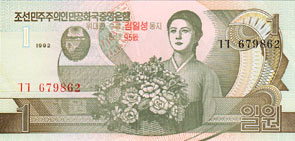 | 1 Won, 1992 Front: Young woman with flower basket at center right, commemorative Korean text at upper center, arms at upper left Back: Mt. Gumgang Watermark: winged equestrian statue ("Chollima") Size: 115 x 55 mm | |||||||||||||||||||||
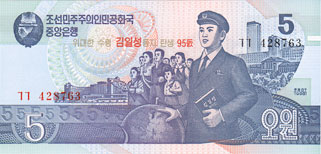 | 5 Won, 1992 Front: Kim Il Sung University in Pyongyang at upper right, Mangyongdae School Childrens' Palace in Pyongyangi at center left, students and pupils at center, symbol of an atom and nuclear power at upper left center, commemorative Korean text at upper center, arms at upper left Back: Grand Peoples Study House on Mansan Hill in Pyongyang Watermark: winged equestrian statue ("Chollima") Size: 125 x 60 mm | |||||||||||||||||||||
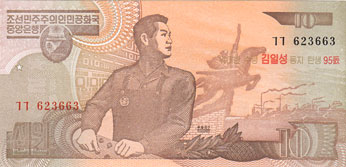 | 10 Won, 1998 Front: Factory worker, winged equestrian statue ("Chollima") at center right, factories in the background at lower right, commemorative Korean text at upper right, arms at upper left Back: Flood gates Watermark: winged equestrian statue ("Chollima") Size: 135 x 66 mm | |||||||||||||||||||||
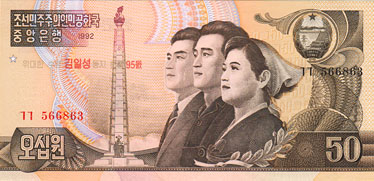 | 50 Won, 1992 Front: Juche Tower at center left, young professionals at center right, commemorative Korean text at upper left, star at upper left mirror-images star on back at upper right, arms at upper right Back: Landscape of pine trees and mountains Watermark: Top of Juche Tower Size: 145 x 70 mm
| |||||||||||||||||||||
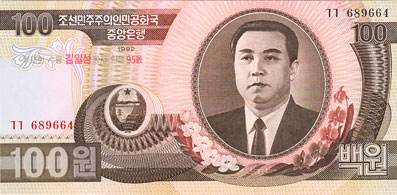 | 100 Won, 1992 Front: Kim Il Sung at center right, commemorative Korean text at upper left, flower design at upper left is mirror-image of flower design on back at upper right, arms at center left Back: Birthplace of Kim Il Sung in Mangyongdae-guyok at center Watermark: Arch of Triumph in Pyongyang Size: 155 x 75 mm | |||||||||||||||||||||
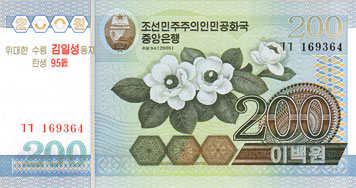 | 200 Won, 2005 Front: Magnolia flowers, the National Flower of North Korea, at center, commemorative Korean text at upper left, arms at upper center left Back: Large value at center Watermark: winged equestrian statue ("Chollima") Size: 139 x 72 mm | |||||||||||||||||||||
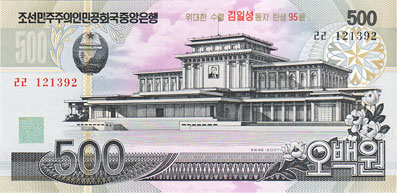 | 500 Won, 2007 Front: Kumsusan Memorial Palace, commemorative Korean text at upper center, arms at upper left, roung ornamental design at upper right is mirror-image of the round ornamental design on the back at upper left Back: Suspension bridge Watermark: Arch of Triumph Size: 155 x 75 mm | |||||||||||||||||||||
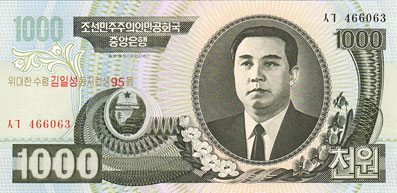 | 1000 Won, 2006 Front: Kim Il Sung at center right, commemorative Korean text at left center, ornamental flower design at upper left mirror-images flower design on back at upper right, arms at center left Back: Birthplace of Kim Il Sung in Mangyongdae-guyok at center Watermark: Arch of Triumph Size: 155 x 74 mm | |||||||||||||||||||||
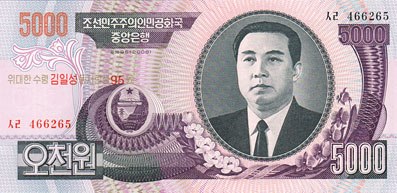 | 5000 Won, 2006 Front: Kim Il Sung at center right, commemorative Korean text at left center, ornamental flower design at upper left mirror-images flower design on back at upper right, arms at center left Back: Birthplace of Kim Il Sung in Mangyongdae-guyok at center Watermark: Arch of Triumph Size: 155 x 74 mm | |||||||||||||||||||||
2008 Commemorative Issue for the 60th Anniversary of North Korea | ||||||||||||||||||||||
| After the defeat of the Japanese occupying troops in WWII, the Korean peninsula was divided by the allies, with the Soviets controlling the north and the United States controlling the south. In 1948, two ideologically opposed Korean nations - the Democratic People's Republic of Korea (North Korea) and the Republic of Korea (South Korea) - were created.
For the 60th anniversary of the country in 2008, commemorative notes were issued — They are 2002 Issue notes with an overprint of Korean text. | ||||||||||||||||||||||
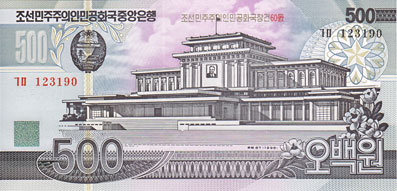 | 500 Won, 1998 Front: Kumsusan Memorial Palace, commemorative Korean text at upper center, arms at upper left, roung ornamental design at upper right is mirror-image of the round ornamental design on the back at upper left Back: Suspension bridge Watermark: Arch of Triumph Size: 155 x 75 mm | |||||||||||||||||||||
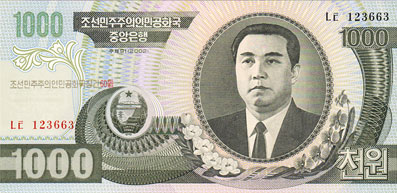 | 1000 Won, 2002 Front: Kim Il Sung at center right, commemorative Korean text at left center, arms at center left Back: Birthplace of Kim Il Sung in Mangyongdae-guyok at center Watermark: Arch of Triumph Size: 155 x 74 mm | |||||||||||||||||||||
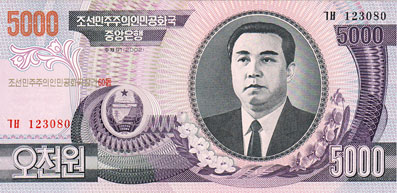 | 5000 Won, 2002 Front: Kim Il Sung at center right, commemorative Korean text at left center, arms at center left Back: Birthplace of Kim Il Sung in Mangyongdae-guyok at center Watermark: Arch of Triumph Size: 155 x 74 mm | |||||||||||||||||||||
2009 Third Won Issue | ||||||||||||||||||||||
| In December 2009, the government of North Korea devalued its currency in a bid to stem runaway inflation. North Korea announced on state radio that the exchange rate would be set at 100 old won to 1 new won, and residents were only allowed to exchange 150,000 won for the new currency. Cash in excess of the allowed amount must be stored in government-run banks.
The current series of banknotes of the third won are issued in values of 5, 10, 50, 100, 200, 500, 1000, 2000, and 5000 won. Kim Il-sung is depicted only on the front of the highest denomination, with the 100 won note featuring the Magnolia (the National Flower) and other notes depicting generic people or various monuments in North Korea. The exchange rate was 100 second won to 1 third won On the bills of 5, 10, and 50 won there is the issuing year, which happens to be "Juche 91, 2002." Therefore, there is a high possibility that they were printed in 2002 when the July 1st Economic Management Reform Measures were adopted. However, on bills worth 100, 200, 500, 1000, 2000, and 5000, "Juche 97, 2008" was printed as the issuing year. In fact, there were rumors almost every year that a redenomination would be carried out, so there is the possibility that the authorities produced the new denominations in 2002 and have been waiting for the appropriate time to release them. Indeed, in July, 2002, one of the key reasons why prices soared and the currency lost so much value was a rumored redenomination. There is one more possibility: that North Korea wants to emphasize the year 2002 as the starting point of the "new economic management system." In the future, were the North Korean economy to be stable, then the authorities would be able to imply that that stability was the result of the July 1st Economic Management Reform Measure.
| ||||||||||||||||||||||
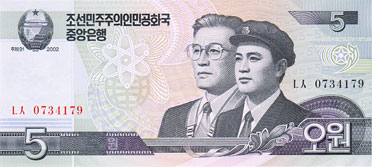 | 5 Won, 2002 Front: A scientist and a student at center right, arms at upper left Back: Hydroelectric dam at center Watermark: Mongnan (Seibold's Magnolia) flower Size: 145 x 65 mm
| |||||||||||||||||||||
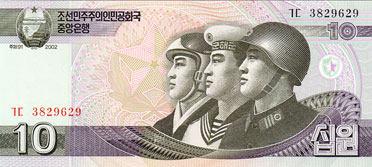 | 10 Won, 2002 Front: Soldiers of Air Force, Navy, and Army at center right, arms at upper left Back: Monument to Victory in the Victorious Fatherland Liberation War in Pyongyang at center Watermark: Mongnan (Seibold's Magnolia) flower Size: 145 x 65 mm
| |||||||||||||||||||||
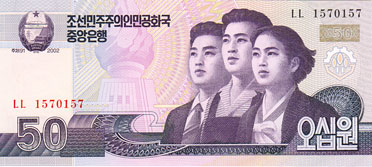 | 50 Won, 2002 Front: An engineer, a farmer, and a working intellectual at center right, arms at upper left, flame on the top of Juche Tower in background at center left Back: Monument to the Founding of the North Korean Workers' Party in Pyongyang at center Watermark: Mongnan (Seibold's Magnolia) flower Size: 145 x 65 mm
| |||||||||||||||||||||
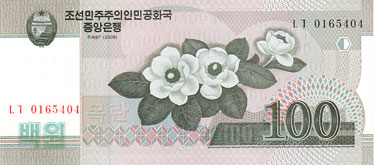 | 100 Won, 2008 Issue Date: 30 November 2009 Front: Mongnan (Seibold's magnolia) at center, arms at upper left corner Back: Denomination at center Watermark: Mongnan (Seibold's Magnolia) flower Size: 146 x 65 mm | |||||||||||||||||||||
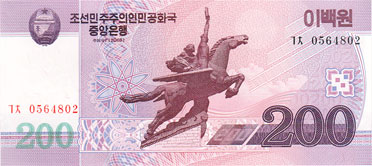 | 200 Won, 2008 Issue Date: 30 November 2009 Front: Collima at center, arms at upper left corner Back: Denomination at center Watermark: Mongnan (Seibold's Magnolia) flower Size: 146 x 65 mm | |||||||||||||||||||||
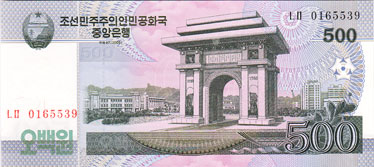 | 500 Won, 2008 Issue Date: 30 November 2009 Front: Arch of Triumph at center, arms at upper left corner Back: Denomination at center Watermark: Mongnan (Seibold's Magnolia) flower Size: 146 x 65 mm | |||||||||||||||||||||
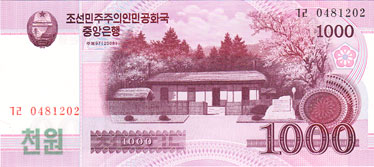 | 1000 Won, 2008 Issue Date: 30 November 2009 Front: House in Hoiryeong which is the birthplace of Kim Jong Suk, Kim Il Sung's first wife and Kim Jong Il's mother, arms at upper left corner Back: Birch trees on the shore of Samji Lake at center Watermark: Mongnan (Seibold's Magnolia) flower Size: 146 x 65 mm | |||||||||||||||||||||
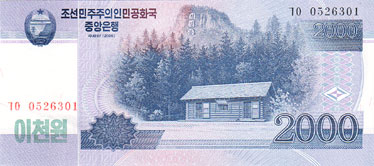 | 2000 Won, 2008 Issue Date: 30 November 2009 Front: Log cabin on Baekdu Mountain, Jong Il Peak, which is the birthpace of Kim Jong Il, arms at upper left corner Back: Baekdu Mountain at center Watermark: Mongnan (Seibold's Magnolia) flower Size: 146 x 64 mm | |||||||||||||||||||||
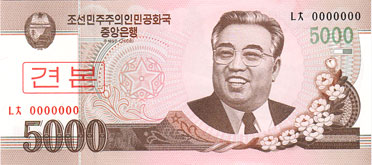 | 5000 Won, 2008 Specimen Note Issue Date: 30 November 2009 Front: Kim Il-sung Back: Mangyongdae Watermark: Mongnan (Seibold's Magnolia) flower Size: 145 x 65 mm | |||||||||||||||||||||